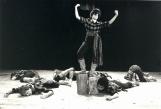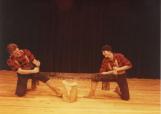1
The year 1981 will mark a turning point in the life of Les Sortilèges since they will, in August of that same year, become a professional troupe.From 1986 and on, they will call themselves the Ensemble National de Folklore les Sortilèges.
This professional period will correspond to the advent of actual choreographed scenes in Les Sortilèges' performances. Their costumes will become more elaborate and choreographers will be invited to work with the troupe.
2
A few Costumes from the Professional Period.For three years, Les Sortilèges have been presenting Turkish dances from the Silifke region when, in 1982, they are offered a sumptuous gift, presented to them through the Turkish Embassy in Ottawa: they are magnificent costumes from the Silifke and Bitlis regions and aprons from the Sivas province.
The following year, the troupe will be touring Turkey.
3
Turkish Costumes : Bitlis (man) and Silifke (woman)Contemporary, 20th century
Province of Bitlis, region of Eastern Anatolia and Silifke (Mersin) Mediterranean region, Turkey
 Credits:
Credits:MBDC
Fortin, Ghislaine, photographer
4
Dancers from Les Sortilèges in Turkish costumes from the Bitlis Region1983
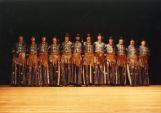 Credits:
Credits:MBDC
Fortin, Ghislaine, photographer
5
Description of Turkish costumes:The colors of these particular costumes shimmer with floral or geometric prints. Red is a recurrent color as it is reputed to ward off evil or diabolic influences. So is henna, which is used to stain certain parts of the body. Pants are wide and billowy. Religion and custom demand that both men and women hide their hair, therefore men are wearing a turban and women a fez, a small round hat, adorned with coins and draped with a scarf.
The Silifke costume, typical of the village of the same name in the southern part of Turkey, was still worn in the 20th century by the Turkmen, a nomadic people. The costume has changed little in the last one hundred years. The sound of wooden spoons, played by the dancers themselves, gives the dance its rhythm.
The Bitlis costume also comes from the village of the same name in Eastern Turkey, between Syria, Iraq and Armenia. The region is far from large urban centres and its people are still wearing this costume.
Source: Les Sortilèges's Costume Repertoire, colligated in 2001 by Isabelle Jeannotte-Pélissier, seamstress.
6
Dancers from Les Sortilèges in Turkish costumes from the Bitlis Region1983
 Credits:
Credits:MBDC
Fortin, Ghislaine, photographer
7
Dancers from Les Sortilèges in Turkish costumes from the Silifke Region1983
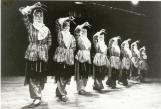 Credits:
Credits:MBDC
Fortin, Ghislaine, photographer
8
''Les Sortileges: Canada's Folk-lore Ambassador to the World'', Turkish Daily News15 October 1982
Ankara (Central Anatolia), Turkey
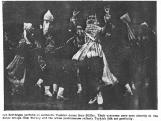 Credits:
Credits:MBDC
Turkish Daily News
9
The lumber jack costume was made in 1983 in Les Sortilèges's workshop and it first appeared on stage in "La Gigue des Bûcherons". This costume was representative of the agricultural workers' winter dress, as they labored in lumber camps."Throughout the 19th century, Québécois and Irish workers would find themselves in lumber camps and dance the jig together. So that it was the Irish influence that brought the jig to the Québecois repertoire."
Jimmy Di Genova, founder and general and artistic director of Les Sortilèges, from 1966 to 1999.

